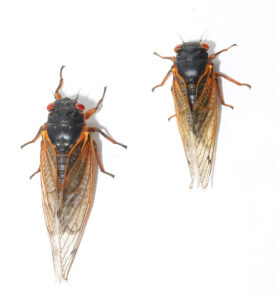 Measuring in at 1 1/2 inches long, with lacy burnt orange wings and red eyes contrasting their black bodies, periodical cicadas will soon emerge from the ground by the millions across Illinois and the Midwest.
Measuring in at 1 1/2 inches long, with lacy burnt orange wings and red eyes contrasting their black bodies, periodical cicadas will soon emerge from the ground by the millions across Illinois and the Midwest.
While the idea of millions of giant bugs crawling from the ground may seem like the start of a horror movie for some, Ken Johnson looks forward to this phenomenon.
“I’m kind of an insect person to begin with,” Johnson explains. “As a kid, I’d collect insects, and in college, I took an entomology (study of insects) class that rekindled that interest. That made me want to pursue [it] as a career.”
He went on to an entomology internship at Walt Disney World Resort in Florida, where he maintained insect colonies and assisted with pest monitoring. Today, Johnson is a horticulture educator with the University of Illinois Extension office based in Jacksonville, where he helps people better understand fruit and vegetable production, pest management and beneficial insects.
This year marks the first time in 221 years that two broods of periodical cicadas will emerge from the ground simultaneously in Illinois, which will cover the state. While there are cicadas that come out annually, Brood XIII, found in the northern half of the state, emerges every 17 years, and Brood XIX, in the southern half, emerges every 13.
“In Illinois, we’ve got both those broods coming out at the same time, which hasn’t happened since 1803,” Johnson explains. “They’ll all just have this mass emergence. There’s something cool about that.”
According to Johnson, once the ground warms up to 64 degrees Fahrenheit at about 8 inches deep, that’s when the cicadas will begin to emerge, particularly if it rains around that time, too. This is expected to occur in May and June.
While the two broods are predicted to come out at the same time, they won’t necessarily come out in the same place. “They’re not expected to overlap to any great extent,” Johnson explains. “Maybe some around the Springfield area, but not any significant amount.”
The number of cicadas will depend on the area. If there are fewer trees, the fewer the cicadas. “The more trees you have, you’ll have more cicadas coming out,” Johnson says. “And [there] could be really high quantity areas … tens of thousands of cicadas, if not hundreds of thousands.”
While you shouldn’t expect to see swarms of cicadas, you should expect to hear them. “The males will sing to attract females, beginning a couple of days after they emerge,” Johnson says. “Depending on the number of cicadas you have, it could get rather loud.”
According to the National Institutes of Health, the “singing” could reach more than 90 decibels, which compares to the same noise level as a lawnmower, tractor or motorcycle.
Once they mate, the females will begin laying eggs in woody plants. “If you’ve got newly planted trees, small trees and shrubs, [cicadas] can cause significant damage to those plants while laying eggs,” Johnson explains. “Large, mature, healthy and established trees are not a concern.”
To protect these plants, Johnson recommends covering them with netting. Openings in the netting shouldn’t be larger than a 1/4 inch so the cicadas cannot lay their eggs. These nets can be found online and in most garden centers. Johnson says to be sure to secure the netting to the base of the tree so they cannot crawl up the trunk.
If you were planning to plant a new tree this spring, Johnson suggests that you wait. Although it isn’t an ideal time, new trees are more likely to survive this year if planted at the end of June or the beginning of July, after all the cicadas are gone.
In addition, Johnson warns against using insecticides. Doing so will run the risk of affecting other insects you’re not trying to control, like much-needed pollinators. “Netting is going to be the best way to protect your plants,” he says.
Once the cicadas emerge, they will be around for about six weeks, and then they will begin dying off. “When they die, it’s not going to be particularly pleasant-smelling,” Johnson warns.
While considering the noise, potential plant damage and the ensuing odor of rotting bugs, Johnson hopes people will focus on the positives that these periodical cicadas will also bring.
“They’ve been in the ground for [years]. When they climb to the surface, they will open holes in the soil, making it easy for rain [to nourish plants],” Johnson says. “While emerged, they’re going be food for a lot of wildlife … for all kinds of birds and mammals. And when they’re dying, they may smell, but those bodies will break down and return nutrients to the soil … and will promote a new flush of growth the following year.”
While Johnson looks forward to the mass emergence of cicadas for the experience itself, he also looks forward to eating them for the first time. Yes, you read that correctly. On his Good Growing podcast with Chris Enroth, a fellow U of I Extension horticulture educator who also writes columns for the GardenWise section in this magazine, the two plan to release an episode in late May featuring cicada taste testing. Go to go.illinois.edu/goodgrowingpodcast or your preferred podcast platform to access the episode.
Johnson has found cicada cookbooks featuring a variety of recipes. The insects will emerge from the ground in the evening and are best harvested while still milky white (teneral) before their exoskeletons harden. However, he says people should avoid eating cicadas if they have a shellfish allergy, if the insects emerge from an area where pesticides have been used or if heavy metals in the soil are a concern.
If you want to experience the cicada song, Johnson recommends going to areas with large, mature trees, such as parks and forest districts. While you will certainly hear them, you can also catch a glimpse of them flying around the treetops.
“Enjoy it; they’re not going to be around long, and it’ll be another 13 or 17 years before we see them again,” Johnson says. “They’re not anything you need to kill or get rid of. Just enjoy them while they last.”










